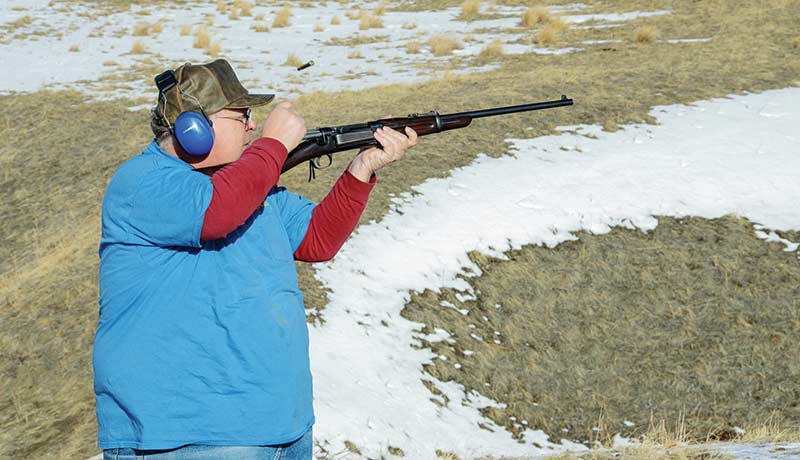Duke shooting Springfield Armory M1A .308 Winchester/7.62mm NATO replica of M14.
The U.S. Army has held onto the basic AR platform since adopting the M16 in 1964. Model 1903 Springfields were standard issue for over 30 years and M1 Garands stayed in service for over 20 years. Of course .30-06 was chambering for both ’03s and M1s so that cartridge actually served for over 50 years.
The Also-Rans
Three short-timers were the flip side of that coin. They were .50 Gov’t “trapdoor” Springfields — 1866 to 1873, .30 U.S. Army bolt action Springfields — 1892 to 1903 and select-fire 7.62 NATO M14s, which were standard from 1957 until the advent of M16s. We civilians have awarded these three cartridges with our own monikers — .50-70, .30-40 Krag and .308 Winchester.
When the army adopted the .50 Gov’t Model 1866 “trapdoor,” it was a milestone in American military arms. These rifles were a breech-loading design using a centerfire cartridge whereas standard issue for infantry in the just-finished Civil War had been .58 cal. muzzleloading muskets. Along with later Models 1868 and 1870, “trapdoor” .50s served in almost all of the Plains Indian battles until the mid-1870s and the cartridge itself became a favorite of professional bison hunters of the 1870s.
Krag It Up
Another first was the .30 U.S. Model 1892, followed by Models 1896, 1898 and a Model 1899 (in carbine form only). “Krags,” as they became commonly known, were America’s first bolt-action infantry rifle likewise chambered for America’s first smokeless powder military cartridge. In both rifle and carbine form, Americans fought with Krags in the Spanish-American War, the Chinese Boxer Rebellion and during the long Philippine Insurrection.
It’s kind of a stretch to label the M14 7.62 NATO as an American-first of any type but I’ll try. It was America’s first infantry rifle to be made from the ground up with select fire capability. This feature in turn made M14s the first American military rifle not available to ordinary civilians after being pulled from service. Most M14s put into troops’ hands did not have the select fire option functional. It’s commonly believed the M14s’ combat experiences were limited to the Vietnam War but the U.S. Army pulled many from storage for use again in Afghanistan and Iraq.
A friend of mine served in the latter country. He was designated as his squad’s marksman and issued an M14 but with only one 20-round magazine. Friends back in the U.S. had to send him more that they purchased on the commercial market.
Usually the adoption of a cartridge by the U.S. military forces ensures it is a success in the civilian sector. Take the .30-06 as a prime example. Adopted by the U.S. Army in 1906, it remains one of the most popular sporting rounds even now. The same is true of the 5.56mm in its several permutations. Civilianized as the .223 Remington, it has been the top varmint cartridge for a half century. It will be interesting to see how the army’s new 6.8x51mm cartridge fares in the civilian market.
Back to Buffalo
As said above, the .50-70 was a popular sporting rifle cartridge in Sharps, Remington, Ballard and other single shots through the 1870s. After bison were near exterminated, .50-70 popularity died also. The original military loading consisted of a 450-grain conical lead alloy bullet over 70 grains of black powder. Velocity was rated at 1,250 fps. I’ve owned Springfield Model 1868, Sharps Model 1874 and Remington No. 1 (rolling block) “Big Fifty” rifles. They ranged from reasonably accurate (Springfield Model 1868) to finely accurate (Sharps & Remington). A load of 65 grains of Swiss 1½ Fg black powder in new Starline brass propelled Lyman’s 450-grain bullet (mold #515141) to 1,190 fps from my rolling block’s 28″ barrel.
My rifle racks hold infantry rifle and cavalry carbine Model 1896 Springfield “Krags.” Both are capable of groups equaling most off-the-shelf modern sporting rifles considering they wore equal sights. The U.S. Army’s standard service load carried 220-grain RN jacketed bullets rated at 2,200 fps muzzle velocity. My handload to duplicate that is 40 grains of Hodgdon H4350 powder under 220-grain Sierra or Hornady RN bullets.
And finally there’s the 7.62mm NATO, aka .308 Winchester. It has been my favorite hunting round in a Model 70 Winchester since 1980 and I also have a Springfield Armory M1A. For hunting, my Model 70 is fed 150-grain Sierra spitzer bullets over 44 grains of IMR3030 for 2,750 fps from its 22″ barrel. The M1A gives 2,640 fps with 168-grain Hornady A-Max bullets over 44.5 grains of Vihtavouri N150.
Service life of the three short-timers was brief but still their place in American military history is assured.



